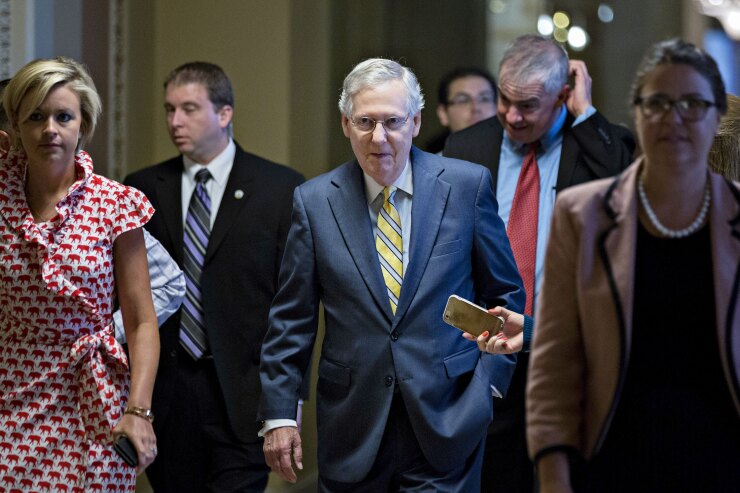The full Senate is expected vote on its version of the tax reform bill as early as this week, and so far, it leaves 401(k) plans and IRAs untouched.
That can always change, however, says Erik Carter, senior financial planner at financial wellness company Financial Finesse, so it is important for employers to keep an ear to the ground as the bill makes its way through debate on the floor.
Currently, “retirement provisions in the bill are not intended to raise money. Most see them as policy improvements,” says Geoff Manville, principal and leader of the government relations team at Mercer’s Washington Resource Group. The bill would ease non-discrimination testing rules for closed pension plans, which is “aimed at enhancing retirement security and plan participation rather than raising money,” he says. “Some of those won’t have much of any revenue effect so they may be dropped because these won’t impact the federal budget.”
Both the House and Senate bills eliminated changes to non-qualified deferred compensation and any references to forced Rothification or cuts to tax incentives for retirement plans.
“One of the reasons Republicans avoided Rothification, beyond Trump’s tweet to Congress to not even think about it, is it would affect a lot of people, especially the middle class,” Manville says.
The initial idea that was discussed, but never made it into either bill, would have cut the tax-deferred contribution limit on 401(k) plans from $18,000 a year to $2,400 annually. Any deferrals over that cap would be given the Roth after-tax treatment.
“The pre-tax deferral element is a big selling point for defined contribution plans and there’s been a huge worry that trading away that tax incentive today will result in less take home pay if you don’t change your deferral rate,” Manville says. “It might increase cash-outs if you need to put after tax money in there and discourage people from offering plans. We are happy that is out.”
Still, Manville points out that “we’re not entirely out of the woods yet. It could theoretically be revived on the floor or during House/Senate talks if they need more revenue. We are guardedly optimistic.”
Paul Strella, senior partner for Mercer LLC, says that “the big news for retirement is what is not in the bill: Rothification and eliminating non-qualified deferred compensation.”
What is left in the Senate bill is “little stuff no one is very interested in,” he says with a laugh.
One provision that is included in the
“What happens to these plans, over time, is the closed group of employees tends to be disproportionately higher paid,” Strella says. At some point the closed plan can’t meet IRS non-discrimination rules and “absent relief, the plan must be frozen. This is not a new problem. It has been around for a few years now.”
The IRS has offered temporary testing relief in the past but more plans don’t qualify for it than do, he adds.
The Senate Bill that came out of the Senate Finance Committee has a provision that would harmonize the contribution limits that apply to 401(k), 403(b) and 457(b) plans effective in 2018, meaning that they all would have a contribution limit of $18,500 in 2018, plus a $6,000 catch-up contribution for people 50 or older.
The Senate bill effectively repeals special catch-up contributions under 403(b) plans and special contribution limitations for governmental 457(b) plans, Strella says.
“This is not an enhancement to the retirement system, but it does simplify a very confusing set of rules,” he adds.
There are many tax preferences in play in the House bill, including achievement awards, adoption assistance, dependent care assistance, educational assistance, on-site gyms, qualified moving expenses, flexible spending accounts and qualified transportation fringe benefits. A lot of language in the House bill would end the tax-free status of these programs, explains Barbara McGeoch, principal at Mercer. If any changes are enacted, employers need to consider what they will do.

If the program is an employer payment, such as an award, the employer should determine if they will continue the program, increase the payment amount to make up for the newly taxed amount or end the program.
“Just because it is not tax free does not mean an employee wouldn’t appreciate getting it,” McGeoch says. “An employer may do it on a taxable basis or up the benefit amount.”
For programs that are currently employee-paid pre-tax, an employer needs to determine if they will end the program or cash out withheld funds. For these programs, such as a flexible spending accounts or a transportation subsidy, where the point of the program is tax-free, ending it might make sense, McGeoch says.
For those flex programs, which are employee- and employer-paid, employers might decide to change the program, since the employee was counting on the employer contribution. Some employers, McGeoch says, might end the program mid-year to allow for new collections.
Companies also should be aware that the employer tax credit for Family Medical Leave Act pay would change in the Senate bill with a maximum 25% credit. This would be under a pilot program in 2018 and 2019. “The first year is nearly upon us,” McGeoch says. “There is little time for prepare.”
Additional reporting by Bloomberg News.





